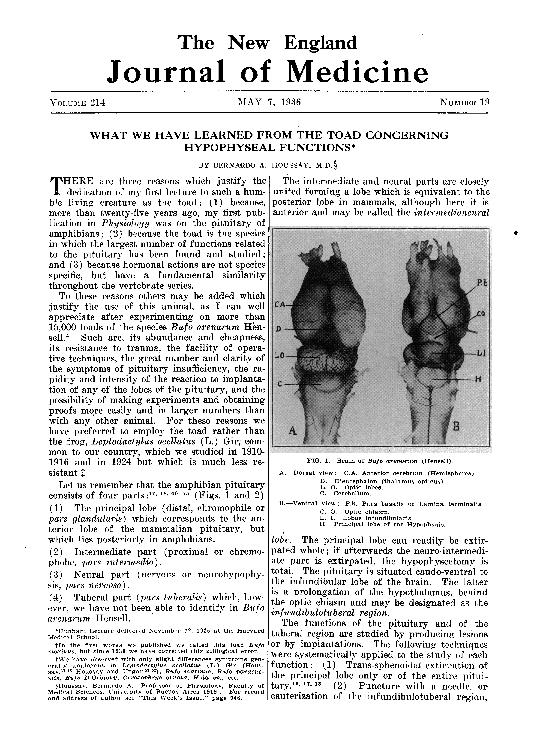Mostrar el registro sencillo del ítem
dc.contributor.author
Houssay, Bernardo Alberto

dc.date.available
2021-01-24T19:04:32Z
dc.date.issued
1936-05-07
dc.identifier.citation
Houssay, Bernardo Alberto; What we have learned from the toad concerning hypophyseal functions; Massachusetts Medical Society; New England Journal of Medicine; 214; 19; 7-5-1936; 913-926
dc.identifier.issn
0028-4793
dc.identifier.uri
http://hdl.handle.net/11336/123524
dc.description.abstract
In the toad the pituitary is a most important organ, as it controls functions which are necessary for the maintenance of the life of the individual and also controls sexual and reproductive activities which are necessary for the maintenance of the species. It is the central organ in the endocrine constellation, as it is necessary for the development and maintenance of the anatomical and functional integrity of the other internal secretory glands. The neuro-intermediate lobe governs various functions: (1) It maintains the normal color of the skin (with its physiological and pharmacological changes) by preserving an adequate melanophore expansion. The secretion of this hormone is regulated reflexly, and is therefore under the control of the central nervous system. (2) It preserves the tone of arterioles and capillaries, thus having an important influence in the maintenance of the arterial blood pressure. (3) It regulates the water metabolism; first, by its action on the kidneys and, secondly, on the skin and other tissues. The principal lobe governs the following functions : (1) The development and maintenance of the thyroid and the gonads (including Bidder's organ). It also provides for their compensatory hypertrophy. An adrenotropic action has not been demonstrated in the adult toad. (2) The occurrence of normal ovulation is due to a pituitary hypersecretion in the female which is reflexly stimulated by the sexual embrace. (3) The development of the thyroid which permits the metamorphosis of the larva into the adult form. (4) The regulation of the casting of the skin (with the formation and desquamation of the horny layer) and also the regulation of the cutaneous glandular secretions. (5) The metabolic functions (carbohydrate metabolism, endogenous protein metabolism, etc.). These are so important, that the loss of pituitary control leads to a state of progressive asthenia, causing death in three to eight weeks. The central nervous system is affected and later the heart, muscles, etc. Injury of the tuber cinereum produces secondary lesions in the pituitary with an initial glandular reabsorption and later a more or less marked state of pituitary insufficiency. It is evident that many of these functions of the pituitary either cannot be seen in mammals or will have less importance than in the toad. I have found many functions in the latter which only later were seen in the mammal. For this reason I have studied each function primarily in the toad and simultaneously or subsequently in the more complex animals, and so have been able to understand its significance more readily. No student of the hypophysis can ignore the valuable valuable results obtained by studying its functions in the toad, and all will feel grateful to this low species for the many secrets it has revealed on such an important organ.
dc.format
text/plain
dc.language.iso
eng
dc.publisher
Massachusetts Medical Society

dc.rights
info:eu-repo/semantics/openAccess
dc.rights.uri
https://creativecommons.org/licenses/by-nc-sa/2.5/ar/
dc.subject
HOUSSAY, BERNARDO A.
dc.subject
HOUSSAY EL INVESTIGADOR
dc.subject
PUBLICACIONES CIENTIFICAS
dc.subject
EL INVESTIGADOR
dc.subject
ENDOCRINOLOGY
dc.subject
INPUNDIBULOPHYPOPHYSAL SYMPTOMS
dc.subject
HORMONES
dc.subject
BUFO ARENARUM HENSEL
dc.subject
PITUITARY HYPERACTIVITY
dc.subject.classification
Fisiología

dc.subject.classification
Medicina Básica

dc.subject.classification
CIENCIAS MÉDICAS Y DE LA SALUD

dc.title
What we have learned from the toad concerning hypophyseal functions
dc.type
info:eu-repo/semantics/article
dc.type
info:eu-repo/semantics/publishedVersion
dc.journal.volume
214
dc.journal.number
19
dc.journal.pagination
913-926
dc.journal.pais
Reino Unido

dc.description.fil
Fil: Houssay, Bernardo Alberto.
dc.journal.title
New England Journal of Medicine

dc.relation.alternativeid
info:eu-repo/semantics/altIdentifier/doi/http://dx.doi.org/10.1056/NEJM193605072141901
dc.provenance
Fundación IBYME/IBYME. Biblioteca Bernardo A. Houssay
dc.format.espacioDeColor
EscalaGris
dc.relation.jurisdiccion
Ciudad de Buenos Aires
dc.format.compresion
Si
dc.relation.organismoFinanciador
Fundacion Williams.

dc.relation.organismoFinanciador
Fundación de Instituto de Biología y Medicina Experimental

dc.relation.organismoFinanciador
Consejo Nacional de Investigaciones Científicas y Técnicas

dc.relation.nombreProyecto
Proyecto Houssay y Leloir
dc.description.nivelDescripcion
Unidad documental simple
dc.type.subtype
Artículo científico
dc.type
info:ar-repo/semantics/artículo
Archivos asociados
